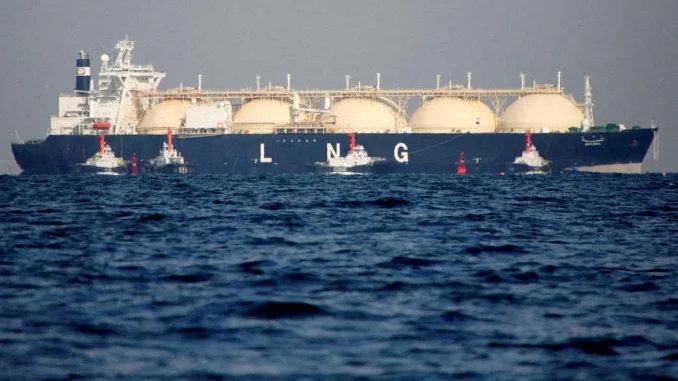
SINGAPORE – Prices of liquefied natural gas (LNG) have continued easing through the start of the fourth quarter due to lower demand, thanks to a warmer start to winter, but the market remains fundamentally tight, industry sources said.
Analysts and traders warned against misconstruing images of a flotilla of LNG tankers filled with the super chilled fuel, waiting to discharge outside Europe’s key receiving terminals as a signal that the energy crisis has ended.
Mr Toby Copson, global head of trading and advisory at Trident LNG, said the market was facing significant supply risks despite Europe and Asia having built up healthy inventories in the months before winter.
“Europe has done a great job of building up inventories, which are almost full, but there still remains a significant energy security issue going forward,” he said.
“There are many factors, including a potential cold snap, which would drain storage, and the re-emergence of China in the spot market could keep prices elevated for some time.”
Mr Henning Gloystein, director of energy, climate and resources at Eurasia Group, said it was too early to call an end to the energy crunch that has gripped the world, adding that despite the recent lull in prices, there were still significant upside price risks.
“We’ve said for a while, actually since May, that Europe’s efforts to get through this winter without Russian gas would succeed, but at huge costs and at future risks of disruptions,” he said.
“Come spring 2023, utilities must immediately refill their gas storages to fulfil mandatory targets ahead of next winter, likely raising the cost of additional LNG supply to replace Russian gas.”
Mr Steve Tan, vice-president of strategic content at Opis, a price reporting agency for energy and commodities, said that buyers in Europe would continue to compete fiercely with those in Asia for spot LNG cargoes, and this would keep prices elevated going into 2023.
He said: ”We expect tight global LNG supply over the summer and winter of 2023. Any unforeseen supply disruptions during this period will cause prices to spike.”
According to data from Opis, the average LNG price for a spot cargo being delivered to north-east Asia was around US$28 per million British thermal units (mmBtu), considerably lower compared with prices for October that hovered around $45 to $50.
He added that the recent dip in prices had stirred up some intermittent purchases by Japan and South Korea, but he noted that these were probably opportunistic deals and did not expect to see this continue through the winter.
“Recent prices are half of where they were a few months ago at above $50 per mmBtu, unlocking slightly more demand in Asia but not by much,” he said
Mr Alex Siow, lead Asia gas analyst at data intelligence company ICIS, said that Japan and South Korea had built up record inventories, which ICIS estimated to be around 6 million tonnes respectively in both countries as at November.
He noted that for the same month in 2021, ICIS estimated that Japan had built up close to 5.5 million tonnes of gas inventory. He said South Korea had never exceeded storage capacity of over 5 million tonnes.
“Like Europe, the big Asian buyers rushed to build their inventories as the market started to tighten. They were driven by concerns over further tightening of the LNG market ahead of winter,” said Mr Siow, adding that the market remained tight.
Mr Siow added that LNG buyers were now planning their potential procurement programme for the summer months of 2023, and that the market outlook was starkly different compared with the same period in 2022.
“At the moment, Russian gas is flowing at a significantly lower rate into Europe. In everyone’s mind, this can go down to zero any time. Even if it continues at this level, this is the lowest level of Russian gas ever into Europe.”
With competition for spot LNG expected to remain fierce and prices expected to remain high, developing countries and emerging market economies are likely to continue to be forced towards opting for cheaper alternatives such as diesel or fuel oil, said Mr Yaw Yan Chong, director of oil research at Refinitiv, a unit of the London Stock Exchange Group.
The super chilled fuel is priced in US dollars, and a single shipment is estimated to cost around US$100 million. For comparison, LNG shipments averaged US$33 million during the 2010s.
“It is cheaper for countries like Pakistan and Bangladesh to burn more gasoil and fuel oil; and with a stronger dollar and weaker local currency, it just makes economic sense for them to make the switch,” he said.
Pakistan’s foreign exchange reserves dropped to the lowest level in three years in October, pushing the nation’s credit rating by Moody’s Investors Service deeper into junk. Reserves for Bangladesh, India and the Philippines are at two-year lows.
“With this kind of credit ratings, suppliers would also be cautious about locking in large volume contracts. With gasoil and fuel oil, volumes are much smaller – and the relative costs, easier to digest,” Mr Yaw added.



